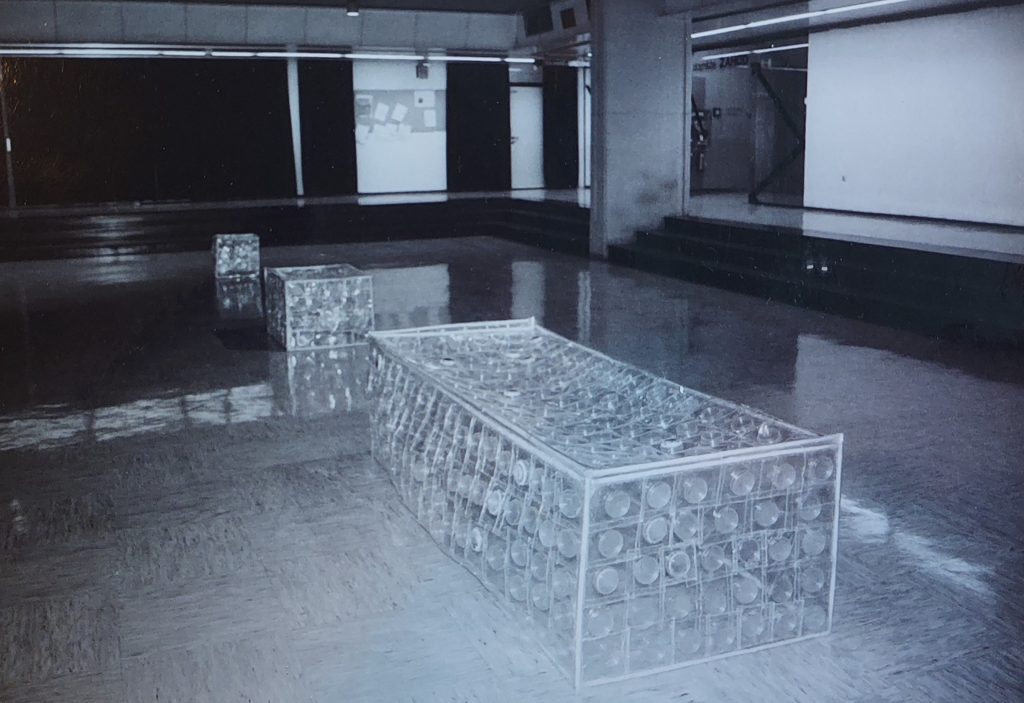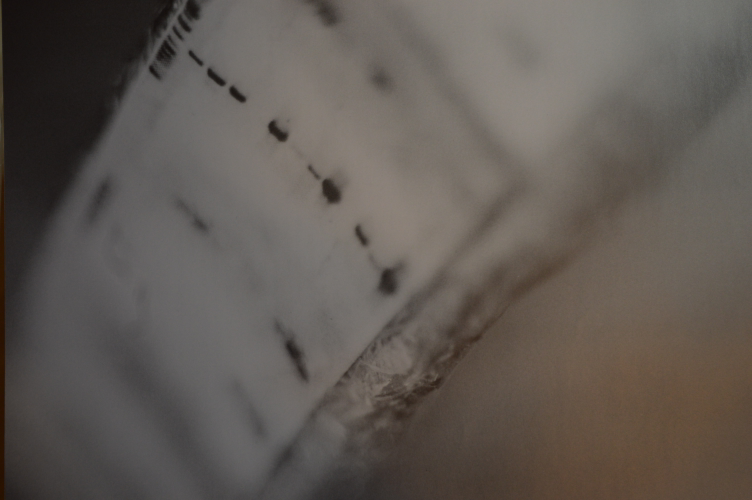Your cart is currently empty!
Mojca Založnik
- PRETOK – FLOW – 2006, Galerija Pef, Razstava 1+1 Profesorji in študenti
Delo zajema odsek pretoka nekakšne cevi iz poliestrske smole in trtnih vej, ki je vmesnik za bakterijske petrijevke, ki so vnešene v ta vmesnik. Bakterijske petrijevke so bile avtoklavirane skupaj s sevi in plastiko v kovinskem nosilcu in so se temu primerno deformirale. Plastični skupki so nekakšni organski nosilci tega, kar je bilo včasih gojišče za živjenje, sedaj pa je vsaj večinoma znotraj še vedno gelan gel. Sedaj je sterilen in preobražen v organskih oblikah, ki so iz prozornih postale bele. Asociirale naj bi na pretok reke oziroma njen izsek. Hotela sem prikazati stanje, ki je vmes med živim in mrtvim oziroma sterilno, očiščeno, stanje pretoka, ki je vmes…ki povezuje tako eno kot drugo in je nekakšen prehod.


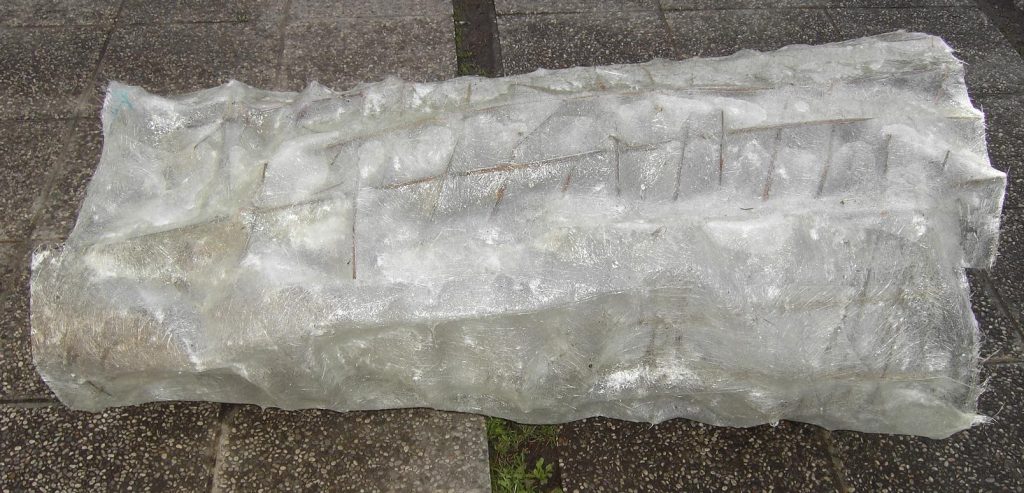
FLOW – 2006, Pef Gallery, Exhibition 1+1 Professors and Students
Work is a some kind of pipe from poliester resin and vine brancehs. It works as a kind of intermediary for bacteria Petri dishes who have been put inside. The petri dishes were autoclaved with plastic in a metal carrier and were accordingly deformed. Plastic sets are somehow an organic carrier for what was a medium for living bacteria cells. Now only glean gel is inside. It is sterile and transformed into organic shapes which are white. They associate on the section of the flow of the river. I wanted to show the state that is in-between the living and the dead or otherwise sterile, cleaned state of the flow, which is in-between, it connects the two states and is a kind of passage.
Reality log/ Environmental scan – 2007
DELAVNICA IN RAZSTAVA S STEPHANOM DOEPNERJEM, P74 Galerija
Delo je bilo postavljeno v okolje, ki je skeniralo galerijo in je skušalo najti povezavo z zunanjostjo. Za povezavo z zunanjostjo je bilo uporabljeno okno, ki pa je gledalo na dvoriščno stran na način, da ni bilo mogoče pogledati znotraj z zunanje strani. Okno nekako služi kot opisna metafora za pogled proti neskončnosti, kamor se nadaljuje sistem, ki je postavljen na tleh galerije. Vibrio sp. iz Škocjanskega zatoka je gojen na agarju in ločen s steklenimi pregradami v katerih je naraščajoča koncentracija soli. Glavni namen dela je povezati sistem s pogledom gledalca in s pogledom proti neskončnosti. Le tega reprezentira okno galerije kamor je silikonska ovojnica pripeta. Koncentracija soli linearno narašča proti neskončnosti. Vpliva pa na produkcijo in barvo pigmenta prodigisionina, ki ga producira bakterija, ko ima višek hranil. Celoten sistem s soljo, agarjem in bakterijami je bil ovit v silikonski ovoj vezan na plastične nosilce in pritrjen na galerijsko okno. Z ezo (palička, ki je uporabljena za gojenje bakterij) je gledalec lahko s tekočo kulturo Vibrio sp. v flaški nekaj napisal ali narisal na površino agarja. Na ta način je vplival na notranjost sistema preko odprtin v silikonskem ovoju. Celoten sistem je kombinacija linearnega sistema, ki predstavlja bakterijsko rast. Barva kolonij je odvisna od koncentracije soli – predstavlja linearen sistem, ki je omejen s pogoji v gojišču; ta sistem pa je lahko sovplivan s strani gledalca, pogled in vpliv katerega je bolj naključen, kaotičen, nenadzorovan; tretji pogled pa je pogled proti neskončnosti, ki oba pogleda združuje. Nekaj kar ni vidno (koncentracija soli) pa vpliva na vidno podobo, ki se s časom še spreminja na agarju.
WORKSHOP AND EXHIBITION WITH STEPHAN DOEPNEr, P74 Gallery
Work was set in an environment, which scanned the gallery and tried to find the connection with the outside. For the connection with the outside window was used, which was looking on the exterior with the way that did not allow the views from the outside side. The window acts as a kind of a metaphor for the view toward infinity toward which the system which is set on the floor of the gallery continues.Vibrio sp. from the Škocjan creek is cultivated on agar and divided with glass barriers in which is the ascending concentration of salt. The main purpose of the work is to connect the system with the view of the viewer and with the view toward infinity. This represents the window of the gallery to which the silicon veil is attached. The concentration of salt is linearly reaching infinity. It affects on the production and colour of prodigisionin, which is produced by bacteria when she has a surplus of nutrients. The whole system with salt, agar and bacteria was wrapped in a silicon veil on a plastic sticks and tied on a gallery window. With the era – plastic stick used to transfer bacteria onto a plate the viewer could draw something on the agar surface. The whole system is a combination of a linear system which represents bacterial growth. The colour of the colonies is dependant from the concentration of salt – it represents a linear system which is limited with conditions in the media; this system could then be influenced from the viewer – the view and effect which is more chaotic, influenced by chance, uncontrolled. The third view is a view toward infinity, that combines both views. Something that is not visible (concentration of salt) is effecting the image, which is changing on the agar with time.
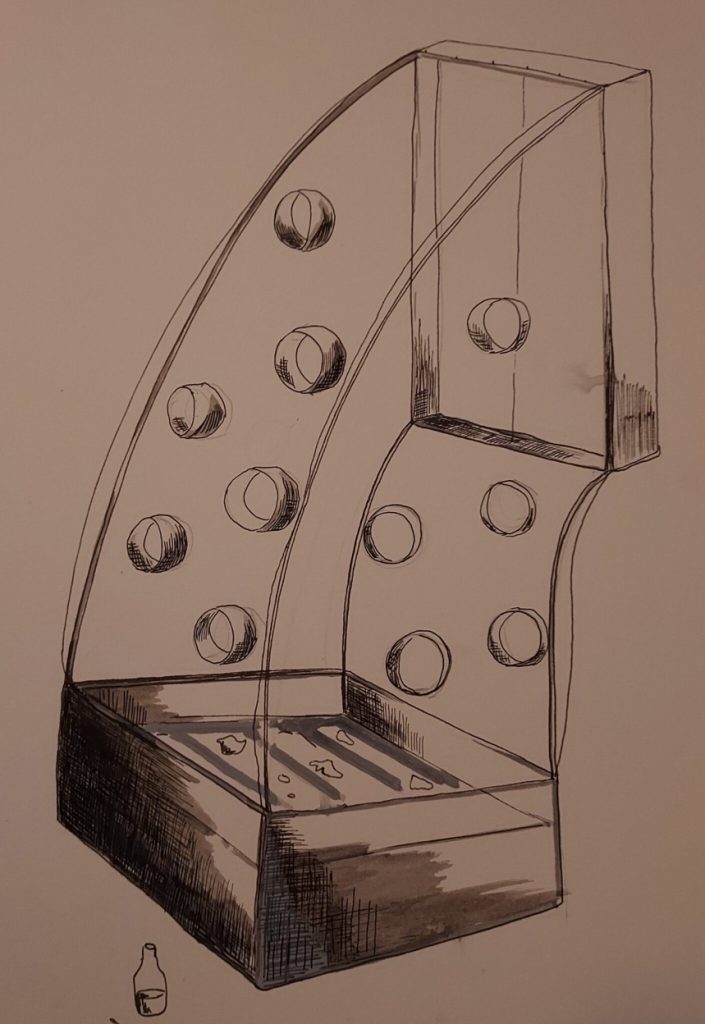
3. METAMORFOZE – WHAT IS MY SOUND? V sodelovanju s Tino Dobrajc in Mitom Gegićem
Delo je bilo zasnovano kot postavitev v okviru študentskih metamorfoz z namenom postavitve ob postajališče mestnega avtobusa. Delo je sestavljeno iz treh lesenih škatel in dveh “mehkejših” diskov na katere so nameščene slike PCR produktov 16S rDNK izolatov bakterij izoliranih iz tal Ljubljanskega barja.
Kot vzor je služil filmski ustvarjalec Petr Kubelka, saj je podana tema, da naj bi delo predstavljalo neke vrste asociacijo na film, pri njem pa gre za filme, ki imajo arhitekturno zgradbo in so sestavljeni samo iz črno belih sličic, kot popolna redukcija na osnovno enoto slikovnega zapisa. PCR produkti izgledajo kot črn fragment na beli podlagi (ali obratno, odvisno od izbire filtra pri slikanju). Nameščeni so vzdolž oboda kolesarske gume in prevlečeni s steklenimi vlakni in premazani z epoksidno smolo. Iz kolesa strlijo 4 plastične paličke, ki nekako predstavljajo prenos nukleotidnega zaporedja (tu je predstavljen kot slika) preko 4 oligonukleotidnih začetnik (A, T, G, C) v aminokislino. V instalaciji pa se te štiri palčke dotaknejo 20 kitarskih strun, ki so nameščene na obod dveh od treh škatel, kjer prihaja do stika. Ko gledalec zavti kolo sproži kolo življenja, simboličen prepis v aminokilisno in ustvarja zvok, medtem ko vrteče se kolo postane filmski trak, ki se vrti in proizvaja gibljivo sliko.
Dva mehka diska asociirata na medvretenčno ploščico, tri trdne škatle pa na kosti, spoj me njimi omogoča gibanje in proizvodnjo življenja, podobe in zvoka hkrati.
Work was made as a set during the student metamorphoses with the intention to set the work near the bus station. The work is made of three void wooden boxes and two “softer” disks on which pictures from PCR products of 16S rDNK from isolates from bacteria isolated from Ljubljana marsh soil. As a reference i took a filmmaker Petr Kubelka, because the given theme somehow suggested an association on film because of the closeness to cinema. He made films in which we can see an architectural composition and are made up of black and white pictures as a total reduction to a basic element of image record. PCR products look like a black fragment on a white surface (or vice versa dependant from the choice of filter when taking pictures). They are set up on a circumference of a bicycle wheel and coated with epoxy resin. From the wheel 4 plastic stick are sticking out and somehow represent the transfer of nucleotide sequence (here represented as picture) through 4 oligonucleotides (A, T, G, C) into amino acid. In installation these 4 sticks touch the 20 quitter strings, which are set on a circumference of the two of the void boxes. When the viewer puts the wheel in motion it triggers the symbolic transcript into amino acid and makes a sound. The wheel in motion becomes a filmstrip, which turns and makes a moving image.



4. REDČENJE DO IZGINOTJA 2007
Na podstavku so glede na izbiro različnih gojišč postavljene različne mikrotitrske plošče. Vanje sem sterilno nalila štiri tipe gojišč, ki nekako reprezentirajo 4 različna očišča pogleda, saj vsako prikaže le določen del mikrobne združbe, ki na tem gojišču uspe zrasti. Koncentracija hranil približno ustreza tisti, ki jo imajo na voljo bakterije, ki živijo na koži (koncentracija je precej nizka v primerjavi z običajnimi koncentracijami, ki se uporabljajo v laboratoriju). Vzorci so bili odvzeti s kože petim različnim ljudem s štirih delov njihovega telesa, ki so si ga izbrali sami. Vzorci so bili sterilno nanešeni za vsakega posameznika na dve različni gojišči. Dodana je še kontrolna mikrotitrska plošča, ki je nismo inokulirali z nobenim vzorcem, služi pa zato, da vemo, da je sprememba barve ali rasti bakterij ali gliv posledica rasti s kože in ne zunanje okužbe. Vsak vzorec sem nato stopenjsko (diskontinuirano – kot bi črno barvo svetlila do bele, vendar nebi prikazala vmesnih faz) redčila s sterilno fiziološko raztopino, kar bi približno zadostovalo, da se v zadnjih luknjicah (šest po vrsti) ali že prej (odvisno od začetnega števila mikroorganizmov na koži) pojavi sterilnost ali mesto, kjer ni več življenja (rasti) niti razgradnje (smrti). Prisotno je samo prozorno sterilno gojišče, ki je rahlo vlažno. Gre za nekakšno očiščenje.
Zanimalo me je mesto, kjer izgine fizična pojavnost življenja in smrti, hkrati pa se le to ne da interpretirati. Po drugi strani pa gre na isti plošči za dva različna pogleda – del vzorca, ki je nanešen v prve jamice, gre proti končnosti ali minevanju. Gre za rast bakterij (ki so vmes med življenjem in smrtjo, saj razgrajujejo mrtvo tkivo in ga vračajo v življenje s tem, da te ostanke vgrajujejo v svoje celice in s tem prispevajo h kroženju snovi), del pa je izbran s strani subjekta (del telesa s katerega je bil vzorec. Zanima me je tudi vpliv subjekta na to kar gledamo (izbira očišča) in pa izbira gojišča ( več različnih objektivnih pogledov). To omogoča, da se ustvarja povezava subjektivnega, objektivnega pogleda in pogleda, ki je izven določljivega (zadnja jamica). Bakterije opazujemo posredno preko TTC (barvni označevalec tetrazolium klorid), ki gojišče obarva rdeče, ko zazna produkte razgradnje, ki so posledica bakterijske rasti. Z lastno minljivostjo smo soočeni le posredno.
Če bi hotela Biolog plošče interpretirati s stališča znanosti (razcep glede gledanja in poimenovanja), bi slike teh plošč obdelala s programom, ki riše drevesa sorodnosti in bi na ta način povezovala te “ portrete “ med seboj.
Dilution until extinction, Pef
On the white setup are set different microtiter plates which are set according to a use of a view. I poured 4 different types of media, which somehow represent 4 different views of the viewer. Each of the media can show us only a certain part of microbial community, which could grow on this media.
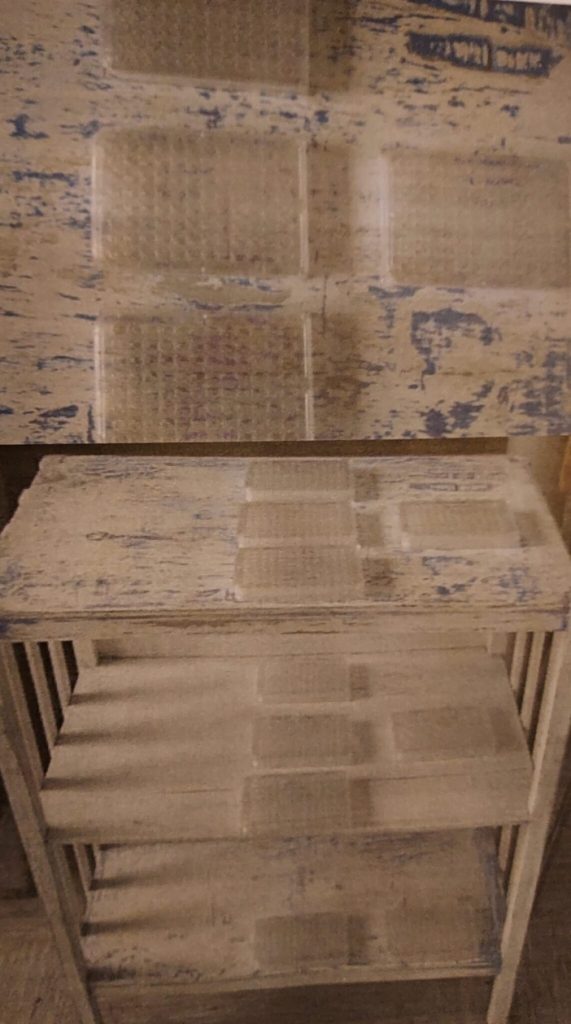
5. PLOŠČA / BOARD – 2007
Na plošči je na način filtra prenesen način razslojevanja dveh bakterijskih združb z vplivom, ki smo ga izbrali mi in ga označujemo kot neodvisno spremenljivko. Vsaka luknja je oznaka za eno bakterijo, ki hkrati odpira pot svetlobi. Način razslojevanja je prikazan po treh mesecih procesa rasti (v časovno prostorski skali) in ustavljen v eni točki v času. Gre za trenutke dokumetacije procesa življenja, vendar ne na način znanstvene dokumentacije procesa življenja, ki bi za to uporabila graf. Spremljevalna os in legenda točno določita kaj naj bi vizualizirani podatek pomenil. Z odstranitvijo legende in s tem da dejstvo označim kot okroglo, želim pogled odpreti tam, kjer ga znanost fiksira.
V te luknje so potem vstavljene epice z bakterijami iz te združbe, vendar je način izbiranja poljuben (bolj kaotičen kot prvi način izbire), zato niso prikazane vse in tudi ne sledijo prvotnemu načinu izbire. Te bakterije so bile skuhane na 100 stopinj Celzlija in s tem uničene. V te epice je bila potem nanešena hrana (gelan gel) in nekatere (ki so uspele tvoriti preživetvene oblike (spore) so po kuhanje ponovno zrasle in so vidne v obliki rumenih kroglic v gelu.
Luknje so oznake za točno določene bakterije, ki imajo svoje mesto v časovno prostorski skali, vendar pa je ta časovno prostorska skala le en način možnega gledanja oziroma označevanja stvari. Dokument tako spremljanega procesa je graf. Spremljevalna os in legenda točno določita kaj naj bi vizualizirani podatek pomenil. Z odstranitvijo legende in s tem da dejstvo označim kot okroglo, želim pogled odpreti tam, kjer ga znanost fiksira. Vmes med epico (kjer je bakterija – označenec iz te mikrobne združbe) in oznako za to bakterije, se zgodi neke vrste prelom (kuhanje na 100 stopinj označuje smrt oz. prelom).
Soočeni smo z dvema stvarnostima: smrtjo in ponovno rastjo. Po G. Bachelardu (1998, 255) se bit zdi okrogla. Ta likovni element sem izbrala namesto numeričnega podatka, ki je stal v grafu. Ker perforira nosilec, se po eni strani odpira v neskončnost, po drugi strani pa epice stopajo v prostor proti gledalcu. Podoba iz pleksi stekla je model, kjer je položaj epic z izbiro spremenljivke točno določen. To je predhodni pogled. Edina spremenljivka je sedaj življenje samo.
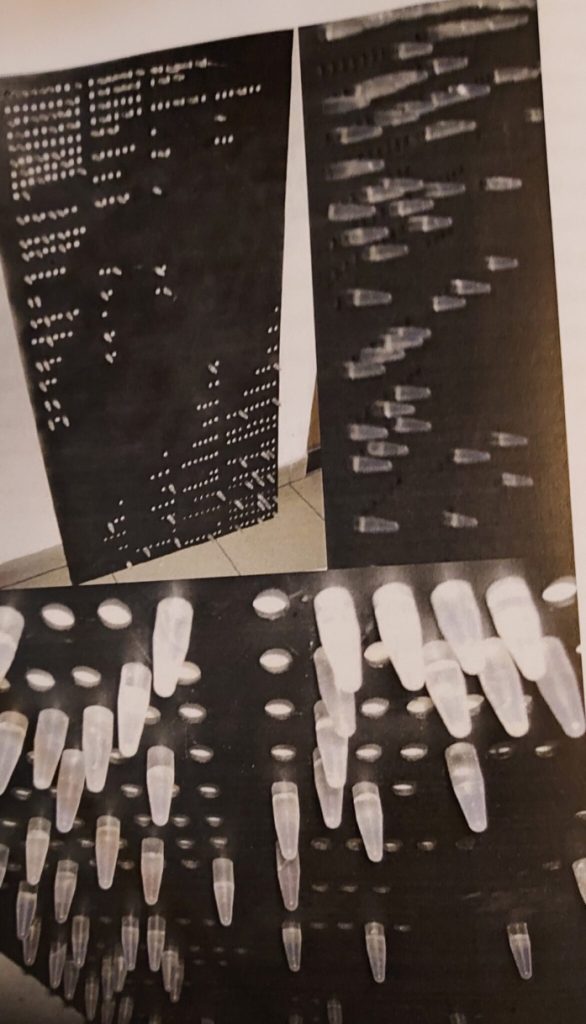
6. ZDRUŽBA/COMMUNITY – 2007
Kosi gline so vstavljeni v podlago, vanje pa je nekako naznačena oblika DNK, ki jo na sliki vidimo kot črn rahlo lobularen fragment. Zapisi na označevalcih (kamnih) za bakterije so dobljeni iz slik PCR produktov 16S rDNK izolacije iz bakterijske združbe. To obliko sem vrezovala v mehko glino. Glinene ploščice spominjajo na nagrobnike. Razporeditev v prostoru je namreč proces rasti mikrobne združbe v času, ki je spremljan v laboratoriju. Kar se je v času zgodilo prej, je sedaj tudi v prostoru spredaj. Ista točka oziroma teden v procesu določa tudi enak nosilec oziroma podlago. Postavitev upošteva diskontinuiranost v času in jo vleče v prostor, vendar tu, če gledalec vidi postavitev s sprednje strani, pride do prekrivanja kamnov – časovno prej, je tudi v prostoru spredaj. Ker bi šlo za postavitev v kvadrat, je prostor tvorjen tako, da so med podlagami, kamor so vstavljeni kamni prazni prostori, kar opisuje način zajemanja – filtriranja resničnosti – in hkrati razlaga način delovanja filtra. Filter je hranilni gel, ki omogoči rast le 1-5 % bakterij iz tal in je na ta način selektiven saj omogoča videnje le enega majhnega dela celote. Ti kamni na podlagah so združeni in postavljeni v prostor na način, kot sem ga uporabila v laboratoriju in je v bistvu zelo podoben perspektivičnemu gledanju.
Vendar kot navaja Detela (2005, 64) ena točka označevalca (kamna) lahko reprezentira več kot eno točko označenega pogleda. Kontakt dveh kamnov v pogledu gledalca, ki reprezentira različna označevalca, ne reprezentira nujno fizičnega kontakta dveh predmetov v označenem prostoru, temeveč je možno, da razmejujoča linija reprezentira tudi neoznačen prostor, razdaljo med njima (Detela 2005, 64). Tako dobim hkrati diskontinuiranost, ki je posledica časovne dokumentacije vertikalne in horizontalne redčitve in pa prekrivanje v prostoru, ki ga v času nisem mogla izmeriti.

7. 16s rdnk na steni oziroma pravilnem pravokotnem formatu 2,5 m x 1,5 m x 5 cm je 63 oprimkov oziroma kamnov nepravilnih oblik iz bele gline. na njih je dešifriran zapis 16s r dnk bakterij iz mikrobne združbe tal ljubljanskega barja. material bele gline in zapisa ni naključen. zanima me problematika nastanka življenja. po precej verjetnih teorijah, naj življenje nebi nastalo v prajuhi, saj ta ni omogočala zadostne koncentracije in bližine molekul dnk, ampak na površinah glin. te so zaradi pozitivnega naboja lahko vezale dovolj veliko koncentracijo molekul dnk, ki so potrebne za nastanek življenja. če se izrazim z biblijskim besediščem – “beseda je meso postala” (nastanek življenja) in prah si in v prah se povrneš (smrt). ali drugače, gre za podobno razmerje kot je tisto me jezikom in svetom; vmes je polje, ki je nedoločljivo, prav tako kot je nedoločljivo polje začetka in konca. chartrand (2007, 1) vzporeja pridobivanje znanja z mitom o drevesu spoznanja dobrega in zlega, od katerega naj človk nebi jedel, saj bi drugače spoznal, da je umrljiv. stavek iz geneze primerja s poseganjem v drevo življenja in smrti, ki ga vidi v obliki dnk heliksa. jabes govori, da je beseda stalno reflektirana z ozadjem, z belino, z nepopisanimi robovi. zapisana beseda je narejena iz praznine. potrebuje se prostor praznega, tišina med eno besedo in drugimi, da bi besedo lahko prebrali. zapisanega ne bi mogli prebrati, če ne bi bilo praznega prostora med besedamo in drugimi, da bi besedo lahko prebrali. prazni prostor med besedami in okrušek tišine omogoči, da izgovorjeno slišimo (jabes 1995). povezani smo z belim znakovne beline in črno znaka postane berljivo na njenem najbolj belem mestu (jabes 1993). njegove misli, je drugače potrebno umestiti v širši kontekst razumevanja sveta, katerega poglavitne enote so bog, knjiga, puščava in beseda. pomembna je njegova dialektika zapisanega in odsotnega, označenega in praznin, črke in beline (strehovec 2003, 201). sama postavitev kamnov ali fragmentov v format je določena s programom clustal x. glede na dobljeno zaporedje , ki smo ga dešifrirali, je bila določena identitea same bakterije, ki smo jo osamili. identiteta se določa tako, da se dobljeno zaporedje primerja z bazo zaporedij vseh že dosedaj identificiranih bakterij in glede na odstotek sorodnosti z določeno že znano vrsto še neidentificirane bakterije. na samem oprimku je tako zapis, preko katerega smo to bakterijo prepoznali (v obliki jezika molekule dnk, ki je sestavljena iz 4 črk: a,t, g, c) in njeno ime. povezava med izvorom in oznako za bakterijo je vzpostavljena preko neposrednega vpisa oznake za bakterijo in fragmenta dnk, preko katerega smo ugotovili identiteto te bakterije. čeprav je potrebno omeniti, da je ta dešifriran fragment po baudrilardu v bistvu simulaker, saj je dešifriranje izvedeno na nakopiranem fragmentu, ne poznamo pa več originalne dnk. povezavo med temi fragmenti določa sistem filogenetskega drevesa (drevo, ki določa izvor, tudi dolžine črt, narejenih z oglejm ustrzajo razcepu v zgodovini). povezav nisem skrila, ampak razkrila, skrita je v bistvu cela računalniška baza. neznana zapis se namreč vzpoeja z že znanimi podatki v bazi in določi njihovo mesto glede na to kar že poznamo. pra v tako določi njihov izvor in povezave. edina nedoločena spremenljivka je meja med življenjem in smrtjo.

8.DREVO RAZGRADNJE (2008)
dimenzija 1,5 m x 1,5 m x 1m

Delo skuša najti mejo med naravnim in umetnim. Rdeče zastekljene pike so vzete s konca procesa razgradnje hranil s strani bakterij. Ti prehranski profili99 so osnova za binarno matriko. Iz matrice smo izračunali dendrogram (drevo, ki je dvodimenzionalno). Veje določajo oddaljenost samih predmetov drug od drugega in od vira. Oddaljenost posamezne organske oblike pleksi stekla je torej določena računsko, keramične palice na zadnji strani pa nekako nakazujejo korenine – izvor. Zato sem se spraševal, kakšen vpliv ima to na naš pogled na naravo. 99 Rezultati, pridobljeni na eni takšni mikrotitrski plošči s 96 luknjami – test je standardiziran in se imenuje BIOLOGEcoplate.
v znanosti na predmet, zato organski deli nekako spominjajo na telo. Ti profili (rdeče nepravilne pike) se nekako pogrezajo v meso – glino in določajo njegovo lego. Razporeditev teh delov je bila izračunana v programu SPSS z metodo hierarhičnega združevanja v gruče (združevanje) in z Jaccardovim koeficientom.100 Podatki, vneseni z branjem s slik, posnetih ob določenem času ob koncu procesa in še ne
digitalizirana. Torej digitalni sloj – prej omenjena matrika, določa položaj vizualnega – in to je posnetek zaustavitve procesa, ki je že tako izločen iz svojega okolja in ga vidimo le posredno – rdeča barva pomeni, da je prišlo do okvare. določenega hranila in s tem rast. Ker gre za profile bakterijske razgradnje (bakterije delujejo kot razgrajevalci, so nekako med življenjem in smrtjo), razporeditev organskih delov na krožniku še dodatno poudari razpad posameznega subjekta in se sprašuje o njegovem izvoru. Znanost namreč izbira del realnosti, ki ga bo preučevala; in analizira z več različnih vidikov ta delni pogled – delni pogled je v tem primeru iskanje fizioloških potencialov101 različnih bakterijskih skupnosti, medtem ko iščemo, kje se ti pogledi srečajo. Vrednost ali postavitev teh slik, dosežena s pridobivanjem dobljenih informacij – v našem primeru so prehranski profili bakterij iz različnih neznanih časov zaostanka opisani v skladu z znanimi merili in standardiziranimi testi102 ter tem bakterijam pripisuje vse iste kategorije različnih lastnosti, ki jih nato omogočajo razvrščanje teh osebkov v določen vrstni red in primerjavo različnih asociacij glede na izbrano spremenljivko. Razvrščanje in umeščanje se izvaja po standardih oziroma bazah podatkov, ki služijo kot referenčni okvir. Ko je ta del končan, te slike ne potrebujejo več, pomembni so le podatki, ki se nato interpretirajo v skladu s predhodno postavljeno hipotezo. Gledalec bo torej soočen s podobami, ki so nekako model ali filtrirna realnost, ki nastane z neposrednim preslikavanjem bioloških podob v glinene plošče. Slike se nato v prostoru razporedijo glede na že interpretirane same sebe.
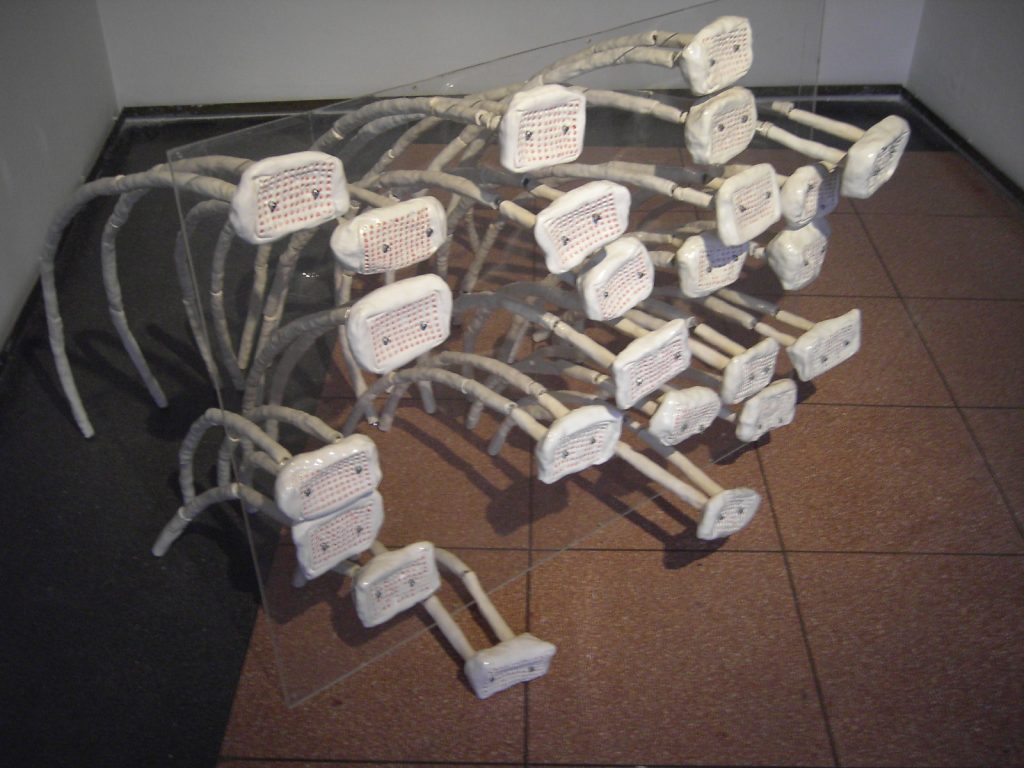
9. MEJNI SISTEM 2008
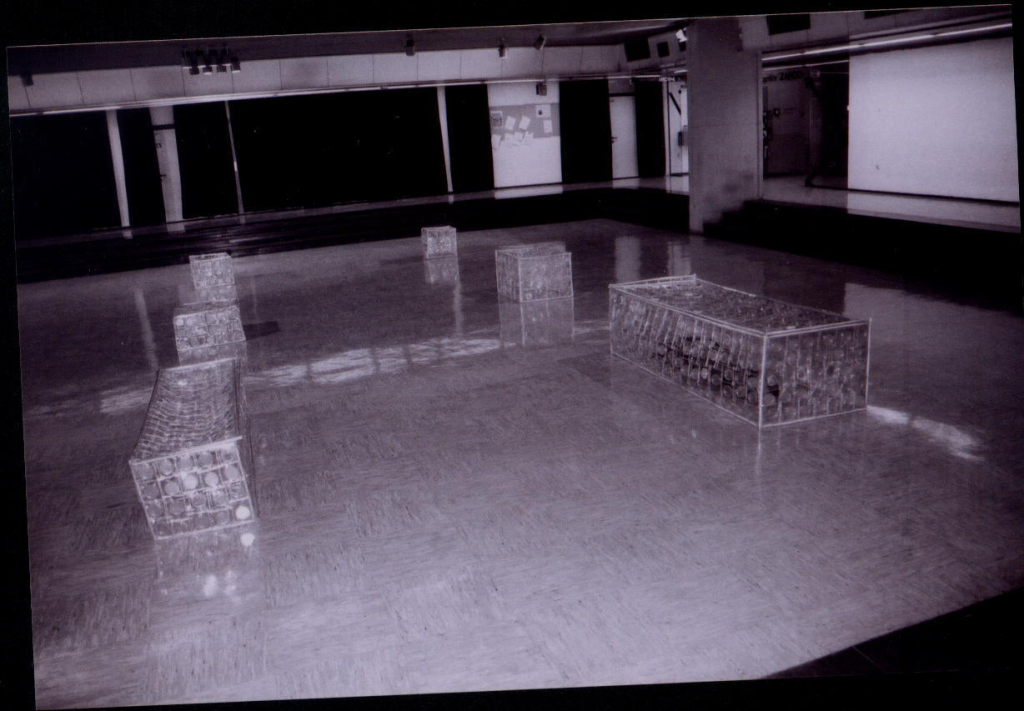
– dimenzije 2,5m x 1m x 75 cm – večja škatla
– 1,8mx1mx75cm-druga večja škatla
– 0,75cmx80cmx30cm-4manjše škatle
– Študija in grafi izdelani na podlagi podatkov, 91 so služili kot podlaga za opravljeno delo.
– Kako vstopimo v smrt – kot to dokončno možnost? V gledalčevi percepciji predstavljam čas zaostanka, 92, vendar za prihodnost, kot čas, ki ga človek potrebuje, da izgine. 90 (ujema se
ogledov – statistična mera za ujemanje med opazovalci) Povezujem ga s časom zakasnitve sevov mikrobne skupnosti, da ocenim čas, ki ga ima posameznik, da izgine (to je čas, specifičen za subjekt). Temelji na ideji, da se v življenju pojavi podobno kot izgine, ostalo kodira.
– Postavitev spominja na eksperiment z mačkami, ki ga je predlagal Erwin Schröedinger.
– Meritev je tista, ki povzroči, da je objekt omejen na eno samo možnost. Iz države
sočasnih možnih stanj (superpozicija) dobimo eno – in hkrati postavimo sistem. Znotraj tega že merjenega sistema sem izbral pot, ki bo ustrezala temu sistemu (objekt bo postavljen tam, kjer je bil izmerjen, hkrati pa želim na tej točki
poiščite nedoločenost). Želim obratno – že vgrajeni sistem postaviti v nedoločeno stanje, omogočiti možnost simultanosti, ki pa je mogoča le z vstopom gledalca (subjekta opazovanja v ložo). Postavitev je kot nekakšeno očišče, skozi katerega gledamo svet, ki nam je sicer neviden in zato potrebujemo podaljške. Gojišče, čas gojenja in redčenje asociacije predstavljajo več očišč, s katerimi želimo zajeti mikrobno pestrost v tleh. A ker v znanosti stremimo k objektivnosti in k temu, da se čim bolj izključujemo, sem s to postavitvijo skušala poseči prav v to vrzel. Gledalca želim postaviti v situacijo, ko fizično vstopi v to matrico – uleže se v škatlo. Na petrijevke sevov, iz katerih smo uspešno pomnožili DNK, sem namestila leče, kar pomeni, da smo znotraj danega očišča vnesli še eno novo, ki nam omogoča vpogled v genetsko strukturo organizma. Ko gledalec vstopi v škatlo, je znotraj minevajočega časa – je linearen in razdrobljen, vendar postavljen v trenutek, kjer je koncentrirana linearnost.
– izmerjeni sistem in negotovost. Osnova, ki določa združevanje, je hipoteza, 96 ki je v znanosti preverjena. Primer spremljanja nenehnega procesa rasti, ki vodi do same manipulacije življenja v laboratoriju. Določanje kraja ali tedna, v katerem se je pojavila določena bakterija, je umetno in je v enem tednu; razmik med skupinami bolj kaže na to, kako
– znanost interpretira realnost, to interpretacijo pa nato prenese v prostor. Delo deluje z
– linearne perspektive (ki poudarja neenakomernost percepcije v znanosti).
– Znanost označi snov kot številko ali kot točko in statistično ovrednoti verjetnost, da
snov sama ustreza tej vrednosti. Konstrukcija prozornih škatel služi prilagajanju merjenih elementov lastnim izmerjenim vrednostim (v tem primeru deformacije, ki so všite v isto konstrukcijo, določajo enak čas izolacije). Vstop v prozorno škatlo podvoji že opravljeno konzerviranje v namen delovnih bakterij (varjenje v PVC folijo) in zavedanje, da vstop v sistem nekako paralizira, ustavi, ubije, hkrati pa prepreči gnitje, a tudi rast. .
– 91 Lešnjak (Založnik) Mojca, (2012), Izolacija in karakterizacija mikrobne združbe iz tal Ljubljanskega barja,
– magistrsko delo, 2012, mentor izr. prof. Ines Mandič Mulec, 89 p.
– 92 Čas, ko se kolonija pojavi na plošči.
